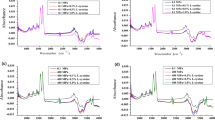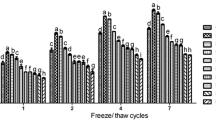Abstract
Sweet potato is one of cheap sources for starch industries worldwide, and exploiting starch wastewater as an alternative protein source is mainly environmental and economic concerns. In this study, the effects of high hydrostatic pressure (HHP; 250, 400, and 550 MPa) on chemical forces, structure, and gelation properties of sweet potato protein (SPP) at pH 3.0, 6.0, and 9.0 were investigated. The values of surface hydrophobicity (Ho) and absolute value of zeta potential of SPP significantly increased from 250 to 550 MPa (p < 0.05) at all three pH conditions. The total amount of sulfhydryl (-SH-) groups in SPP decreased after HHP at pH 9.0, whereas the amount of free -SH- increased. High molecular mass aggregates (> 180 kDa) were observed in SPP after HHP at pH 6.0 and 9.0 by SDS-PAGE. Regarding elastic rheological behaviors, storage modulus (G′) values of SPP were significantly strengthened after HHP treatment. In addition, textural properties and water-holding capacity of gels made from SPP after 250 and 400 MPa at pH 9.0 were significantly improved, and the gels showed a compact and uniform gel network with the contribution of immobilized water fractions. The gel properties exhibited by SPP after HHP treatment at different pH levels, in particular after 400 MPa at pH 9.0, suggested that it could be potential protein resources as new gelling reagent in the food system.






Similar content being viewed by others
References
Angioloni, A., & Collar, C. (2013). Impact of high hydrostatic pressure on protein aggregation and rheological properties of legume batters. Food and Bioprocess Technology, 6(12), 3576–3584.
Arogundade, L. A., & Mu, T. H. (2012). Influence of oxidative browning inhibitors and isolation techniques on sweet potato protein recovery and composition. Food Chemistry, 134(3), 1374–1384.
Arogundade, L. A., Mu, T. H., & Añón, M. C. (2012). Heat-induced gelation properties of isoelectric and ultrafiltered sweet potato protein isolate and their gel microstructure. Food Research International, 49(1), 216–225.
Barba, F. J., Terefe, N. S., Buckow, R., Knorr, D., & Orlien, V. (2015). New opportunities and perspectives of high pressure treatment to improve health and safety attributes of foods. A review. Food Research International, 77, 725–742.
Boutureira, O., & Bernardes, G. J. L. (2015). Advances in chemical protein modification. Chemical Reviews, 115(5), 2174–2195.
Cando, D., Herranz, B., Borderías, A. J., & Moreno, H. M. (2015). Effect of high pressure on reduced sodium chloride surimi gels. Food Hydrocolloids, 51, 176–187.
Chang, C., Tu, S., Ghosh, S., & Nickerson, M. T. (2015). Effect of pH on the inter-relationships between the physicochemical, interfacial and emulsifying properties for pea, soy, lentil and canola protein isolates. Food Research International, 77, 360–367.
Chen, X., Li, P., Nishiumi, T., Takumi, H., Suzuki, A., & Chen, C. G. (2014). Effects of high pressure processing on the cooking loss and gel strength of chicken breast actomyosin containing sodium alginate. Food and Bioprocess Technology, 7(12), 3608–3617.
Cheung, L., Wanasundara, J., & Nickerson, M. T. (2014). Effects of pH and NaCl levels on the physicochemical and emulsifying properties of a cruciferin protein isolate. Food Biophysics, 9(2), 105–113.
De Maria, S., Ferrari, G., & Maresca, P. (2016). Effects of high hydrostatic pressure on the conformational structure and the functional properties of bovine serum albumin. Innovative Food Science & Emerging Technologies, 33, 67–75.
FAOSTAT. (2016). Production quantity [Internet]. Food and Agricultural Organization. http://www.fao.org/faostat/en/#data/QC. Accessed 01/06/18.
Gaspar, A. L. C., & De Góes-Favoni, S. P. (2015). Action of microbial transglutaminase (MTGase) in the modification of food proteins: A review. Food Chemistry, 171, 315–322.
Grossi, A., Olsen, K., Bolumar, T., Rinnan, Å., Øgendal, L. H., & Orlien, V. (2016). The effect of high pressure on the functional properties of pork myofibrillar proteins. Food Chemistry, 196, 1005–1015.
Han, M., Wang, P., Xu, X., & Zhou, G. (2014). Low-field NMR study of heat-induced gelation of pork myofibrillar proteins and its relationship with microstructural characteristics. Food Research International, 62, 1175–1182.
Han, Y., Wang, J., Li, Y., Hang, Y., Yin, X., & Li, Q. (2015). Circular dichroism and infrared spectroscopic characterization of secondary structure components of protein Z during mashing and boiling processes. Food Chemistry, 188, 201–209.
He, R., He, H. Y., Chao, D., Ju, X., & Aluko, R. (2014). Effects of high pressure and heat treatments on physicochemical and gelation properties of rapeseed protein isolate. Food and Bioprocess Technology, 7(5), 1344–1353.
Jia, Y. J., Liang, X. H., & Zhu, W. X. (2010). Separation of β-amylase from sweet potato by different precipitation methods. Food Science, 31, 22–25.
Khan, N. M., Mu, T. H., Zhang, M., & Chen, J. W. (2013). Effects of high hydrostatic pressure on the physicochemical and emulsifying properties of sweet potato protein. International Journal of Food Science & Technology, 48(6), 1260–1268.
Khan, N. M., Mu, T. H., Zhang, M., & Arogundade, L. A. (2014). The effects of pH and high hydrostatic pressure on the physicochemical properties of a sweet potato protein emulsion. Food Hydrocolloids, 35, 209–216.
Khan, N. M., Mu, T. H., Sun, H. N., Zhang, M., & Chen, J. W. (2015). Effects of high hydrostatic pressure on secondary structure and emulsifying behavior of sweet potato protein. High Pressure Research, 35(2), 189–202.
Kim, J. H. J., Varankovich, N. V., & Nickerson, M. T. (2016). The effect of pH on the gelling behaviour of canola and soy protein isolates. Food Research International, 81, 31–38.
Laemmli, U. K. (1970). Cleavage of structural proteins during assembly of head of bacteriophage T4. Nature, 227(5259), 680–685.
Liang, Y., Guo, B., Zhou, A., et al. (2016). Effect of high pressure treatment on gel characteristics and gel formation mechanism of bighead carp (Aristichthys nobilis) surimi gels. Journal of Food Processing and Preservation, 6, 1–8.
Mu, T. H., Tan, S. S., Chen, J. W., & Xue, Y. L. (2009a). Effect of pH and NaCl/CaCl2 on the solubility and emulsifying properties of sweet potato protein. Journal of the Science of Food and Agriculture, 89(2), 337–342.
Mu, T. H., Tan, S. S., & Xue, Y. L. (2009b). The amino acid composition, solubility and emulsifying properties of sweet potato protein. Food Chemistry, 112(4), 1002–1005.
Ni, N., Wang, Z. Y., He, F., et al. (2014). Gel properties and molecular forces of lamb myofibrillar protein during heat induction at different pH values. Process Biochemistry, 49(4), 631–636.
Norton, T., & Sun, D. W. (2008). Recent advances in the use of high pressure as an effective processing technique in the food industry. Food and Bioprocess Technology, 1(1), 2–34.
Peyrano, F., Speroni, F., & Avanza, M. V. (2016). Physicochemical and functional properties of cowpea protein isolates treated with temperature or high hydrostatic pressure. Innovative Food Science & Emerging Technologies, 33, 38–46.
Puppo, C., Chapleau, N., Speroni, F., de Lamballerie-Anton, M., Michel, F., Añón, C., & Anton, M. (2004). Physicochemical modifications of high-pressure-treated soybean protein isolates. Journal of Agricultural and Food Chemistry, 52(6), 1564–1571.
Qin, Z., Guo, X., Lin, Y., Chen, J., Liao, X., Hu, X., & Wu, J. (2013). Effects of high hydrostatic pressure on physicochemical and functional properties of walnut (Juglans regia L.) protein isolate. Journal of the Science of Food and Agriculture, 93(5), 1105–1111.
Queirós, R. P., Saraiva, J. A., & Da Silva, J. A. L. (2018). Tailoring structure and technological properties of plant proteins using high hydrostatic pressure. Critical Reviews in Food Science and Nutrition, 58(9), 1538–1556.
Renkema, J. M. S., Gruppen, H., & Van, V. T. (2002). Influence of pH and ionic strength on heat-induced formation and rheological properties of soy protein gels in relation to denaturation and their protein compositions. Journal of Agricultural and Food Chemistry, 50(21), 6064–6071.
San Martin, M. F., Barbosa-Cánovas, G. V., & Swanson, B. G. (2002). Food processing by high hydrostatic pressure. Critical Reviews in Food Science and Nutrition, 42(6), 627–645.
Sun, X. D., & Arntfield, S. D. (2012). Molecular forces involved in heat-induced pea protein gelation: Effects of various reagents on the rheological properties of salt-extracted pea protein gels. Food Hydrocolloids, 28(2), 325–332.
Sun, M. J., Mu, T. H., Sun, H. N., et al. (2014). Digestibility and structural properties of thermal and high hydrostatic pressure treated sweet potato (Ipomoea batatas L.) protein. Plant Foods for Human Nutrition, 69(3), 270–275.
Tang, C. H., & Ma, C. Y. (2009). Effect of high pressure treatment on aggregation and structural properties of soy protein isolate. LWT-Food Science and Technology, 42(2), 606–611.
Wang, P., Xu, X., Huang, M., Huang, M., & Zhou, G. (2014). Effect of pH on heat-induced gelation of duck blood plasma protein. Food Hydrocolloids, 35, 324–331.
Wang, K. Q., Luo, S. Z., Zhong, X. Y., Cai, J., Jiang, S. T., & Zheng, Z. (2017a). Changes in chemical interactions and protein conformation during heat-induced wheat gluten gel formation. Food Chemistry, 214, 393–399.
Wang, M., Chen, X., Zou, Y., Chen, H., Xue, S., Qian, C., Wang, P., Xu, X., & Zhou, G. (2017b). High-pressure processing-induced conformational changes during heating affect water holding capacity of myosin gel. International Journal of Food Science & Technology, 52(3), 724–732.
Whitmore, L., & Wallace, B. A. (2004). DICHROWEB, an online server for protein secondary structure analyses from circular dichroism spectroscopic data. Nucleic Acids Research, 32(suppl 2), 668–673 http://dichroweb.cryst.bbk.ac.uk. Accessed 13. 02. 17.
Wihodo, M., & Moraru, C. I. (2013). Physical and chemical methods used to enhance the structure and mechanical properties of protein films: A review. Journal of Food Engineering, 114(3), 292–302.
Wu, C., Hua, Y., Chen, Y., Kong, X., & Zhang, C. (2017). Effect of temperature, ionic strength and 11S ratio on the rheological properties of heat-induced soy protein gels in relation to network proteins content and aggregates size. Food Hydrocolloids, 66, 389–395.
Yang, C., Wang, Y., Vasanthan, T., & Chen, L. (2014). Impacts of pH and heating temperature on formation mechanisms and properties of thermally induced canola protein gels. Food Hydrocolloids, 40, 225–236.
Zhang, M., Mu, T. H., & Sun, M. J. (2014). Purification and identification of antioxidant peptides from sweet potato protein hydrolysates by Alcalase. Journal of Functional Foods, 7, 191–200.
Zhang, Z., Yang, Y., Tang, X., Chen, Y., & You, Y. (2015). Chemical forces and water holding capacity study of heat-induced myofibrillar protein gel as affected by high pressure. Food Chemistry, 188, 111–118.
Zhang, Z., Yang, Y., Zhou, P., Zhang, X., & Wang, J. (2017). Effect of high pressure modification on conformation and gelation properties of myofibrillar protein. Food Chemistry, 217, 678–686.
Zhou, A. M., Lin, L. Y., Liang, Y., et al. (2014). Physicochemical properties of natural actomyosin from threadfin bream (Nemipterus spp.) induced by high hydrostatic pressure. Food Chemistry, 156, 402–407.
Zhu, Z., Guan, Q., Koubaa, M., Barba, F. J., Roohinejad, S., Cravotto, G., Yang, X., Li, S., & He, J. (2017). HPLC-DAD-ESI-MS2 analytical profile of extracts obtained from purple sweet potato after green ultrasound-assisted extraction. Food Chemistry, 215, 391–400.
Acknowledgments
The authors gratefully acknowledge the earmarked fund for China Agriculture Research System (CARS-10-B21). We also thank the National Key R&D Program of China (2016YFE0133600).
Author information
Authors and Affiliations
Corresponding author
Ethics declarations
Conflict of Interest
The authors declare that they have no competing interests.
Rights and permissions
About this article
Cite this article
Zhao, ZK., Mu, TH., Zhang, M. et al. Chemical Forces, Structure, and Gelation Properties of Sweet Potato Protein as Affected by pH and High Hydrostatic Pressure. Food Bioprocess Technol 11, 1719–1732 (2018). https://doi.org/10.1007/s11947-018-2137-y
Received:
Accepted:
Published:
Issue Date:
DOI: https://doi.org/10.1007/s11947-018-2137-y




